![cor.movie.night.on.the.galactic.railroad.v2.[D6AA0AD1].mkv_snapshot_00.06.36_[2011.09.21_18.15.21] cor.movie.night.on.the.galactic.railroad.v2.[D6AA0AD1].mkv_snapshot_00.06.36_[2011.09.21_18.15.21]](https://lh3.ggpht.com/-Je6Y7irD-YA/Tnq0oRdTwlI/AAAAAAAATKg/vDaPpeUxw0Q/cor.movie.night.on.the.galactic.railroad.v2.%25255BD6AA0AD1%25255D.mkv_snapshot_00.06.36_%25255B2011.09.21_18.15.21%25255D_thumb%25255B1%25255D.jpg?imgmax=800) |
![cor.movie.night.on.the.galactic.railroad.v2.[D6AA0AD1].mkv_snapshot_00.08.27_[2011.09.21_18.17.25] cor.movie.night.on.the.galactic.railroad.v2.[D6AA0AD1].mkv_snapshot_00.08.27_[2011.09.21_18.17.25]](https://lh6.ggpht.com/-V20hLuCdKmM/Tnq0qL8bMrI/AAAAAAAATKo/PviFeg8W2A0/cor.movie.night.on.the.galactic.railroad.v2.%25255BD6AA0AD1%25255D.mkv_snapshot_00.08.27_%25255B2011.09.21_18.17.25%25255D_thumb%25255B1%25255D.jpg?imgmax=800) |
![cor.movie.night.on.the.galactic.railroad.v2.[D6AA0AD1].mkv_snapshot_00.15.10_[2011.09.21_18.24.09] cor.movie.night.on.the.galactic.railroad.v2.[D6AA0AD1].mkv_snapshot_00.15.10_[2011.09.21_18.24.09]](https://lh3.ggpht.com/-rLRY9Fy9Bcw/Tnq0sQRfnyI/AAAAAAAATKw/ySGwXzNRap8/cor.movie.night.on.the.galactic.railroad.v2.%25255BD6AA0AD1%25255D.mkv_snapshot_00.15.10_%25255B2011.09.21_18.24.09%25255D_thumb%25255B1%25255D.jpg?imgmax=800) |
![cor.movie.night.on.the.galactic.railroad.v2.[D6AA0AD1].mkv_snapshot_00.19.15_[2011.09.21_18.28.14] cor.movie.night.on.the.galactic.railroad.v2.[D6AA0AD1].mkv_snapshot_00.19.15_[2011.09.21_18.28.14]](https://lh3.ggpht.com/-i7lDUpt5Ch8/Tnq0uP2IlHI/AAAAAAAATK4/uOnKSdNt7wc/cor.movie.night.on.the.galactic.railroad.v2.%25255BD6AA0AD1%25255D.mkv_snapshot_00.19.15_%25255B2011.09.21_18.28.14%25255D_thumb%25255B1%25255D.jpg?imgmax=800) |
![cor.movie.night.on.the.galactic.railroad.v2.[D6AA0AD1].mkv_snapshot_00.23.55_[2011.09.21_18.32.54] cor.movie.night.on.the.galactic.railroad.v2.[D6AA0AD1].mkv_snapshot_00.23.55_[2011.09.21_18.32.54]](https://lh6.ggpht.com/-b36GJV7tuUQ/Tnq0wk-5i8I/AAAAAAAATLA/ZKPT4VY7EV4/cor.movie.night.on.the.galactic.railroad.v2.%25255BD6AA0AD1%25255D.mkv_snapshot_00.23.55_%25255B2011.09.21_18.32.54%25255D_thumb%25255B1%25255D.jpg?imgmax=800) |
![cor.movie.night.on.the.galactic.railroad.v2.[D6AA0AD1].mkv_snapshot_00.24.51_[2011.09.21_18.33.50] cor.movie.night.on.the.galactic.railroad.v2.[D6AA0AD1].mkv_snapshot_00.24.51_[2011.09.21_18.33.50]](https://lh3.ggpht.com/-U6ukMAiwRUA/Tnq0yrhSK0I/AAAAAAAATLI/QLY7kLDCsR4/cor.movie.night.on.the.galactic.railroad.v2.%25255BD6AA0AD1%25255D.mkv_snapshot_00.24.51_%25255B2011.09.21_18.33.50%25255D_thumb%25255B1%25255D.jpg?imgmax=800) |
![cor.movie.night.on.the.galactic.railroad.v2.[D6AA0AD1].mkv_snapshot_00.25.46_[2011.09.21_18.34.44] cor.movie.night.on.the.galactic.railroad.v2.[D6AA0AD1].mkv_snapshot_00.25.46_[2011.09.21_18.34.44]](https://lh6.ggpht.com/-3YSN6q5Mmow/Tnq00TCKl-I/AAAAAAAATLQ/19Ee3HTWEm8/cor.movie.night.on.the.galactic.railroad.v2.%25255BD6AA0AD1%25255D.mkv_snapshot_00.25.46_%25255B2011.09.21_18.34.44%25255D_thumb%25255B1%25255D.jpg?imgmax=800) |
![cor.movie.night.on.the.galactic.railroad.v2.[D6AA0AD1].mkv_snapshot_00.29.15_[2011.09.21_18.42.16] cor.movie.night.on.the.galactic.railroad.v2.[D6AA0AD1].mkv_snapshot_00.29.15_[2011.09.21_18.42.16]](https://lh6.ggpht.com/-aw7E_fpSEPg/Tnq02c_mpdI/AAAAAAAATLY/QpulteyD0RU/cor.movie.night.on.the.galactic.railroad.v2.%25255BD6AA0AD1%25255D.mkv_snapshot_00.29.15_%25255B2011.09.21_18.42.16%25255D_thumb%25255B1%25255D.jpg?imgmax=800) |
![cor.movie.night.on.the.galactic.railroad.v2.[D6AA0AD1].mkv_snapshot_00.33.54_[2011.09.21_18.46.54] cor.movie.night.on.the.galactic.railroad.v2.[D6AA0AD1].mkv_snapshot_00.33.54_[2011.09.21_18.46.54]](https://lh3.ggpht.com/-AG_oTjS7MgA/Tnq033f91hI/AAAAAAAATLg/Mo9YmxBj5ns/cor.movie.night.on.the.galactic.railroad.v2.%25255BD6AA0AD1%25255D.mkv_snapshot_00.33.54_%25255B2011.09.21_18.46.54%25255D_thumb%25255B1%25255D.jpg?imgmax=800) |
When Mawaru Penguin Drum premièred in July, it sent hordes of anime fans scurrying towards their search engines to find out more about “Night on the Galactic Railroad”. But this was hardly the first time this influential work has made a splash in Japanese popular culture, and in point of fact it definitely deserves to be appreciated in its own right.
I’m going to spend this review talking about the 1985 anime directed by Sugii Gisaburo, but the source material is a novel by poet and children’s author Miyazawa Kenjii, written sometime in the late 1920’s. That’s the authoritative work, of course, but the film does a pretty good job capturing some of the depth of the book. Sugii made some controversial choices, most obviously changing most of the characters from humans to cats for reasons that aren’t immediately apparent to me. But if you get past that, what you have a truly lovely, thoughtful and heartbreaking film. It’s slow-paced and contemplative to say the least, but it will certainly touch both your intellect and your heart. Be warned that this review contains spoilers about events in the film.
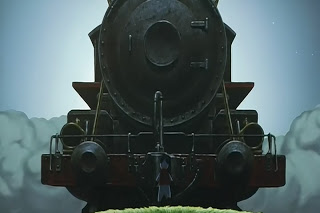 Visually, I was immediately put in mind of an impressionist painting. The colors are beautiful and the images slightly off-focus, always seeming to shimmer and change in front of your eyes. It looks fantastic for a film made more than 25 years ago – as good or better in terms of animation and background as any anime from the 80’s. The story such as it is, is alarmingly simple. In a tiny Italian village a lonely boy (well, kitten) named Giovanni (Tanaka Mayumi) is so poor he must work two jobs to help support his ailing mother and sister. His father is absent – a point noted repeatedly during the film – away on what may be some sort of illegal business in the far North. As a result of all this Giovanni is something of a social pariah, his only friend being the popular, wealthy and kind-hearted Campanella (Sakamoto Chika). On the evening of the Centaurus Festival, Giovanni flees the town after being mocked by the bully Zanelli, and lies down on a hill overlooking the town, gazing at the stars. From out of the sky a train appears, whisking him away on a strange journey through the night.
Visually, I was immediately put in mind of an impressionist painting. The colors are beautiful and the images slightly off-focus, always seeming to shimmer and change in front of your eyes. It looks fantastic for a film made more than 25 years ago – as good or better in terms of animation and background as any anime from the 80’s. The story such as it is, is alarmingly simple. In a tiny Italian village a lonely boy (well, kitten) named Giovanni (Tanaka Mayumi) is so poor he must work two jobs to help support his ailing mother and sister. His father is absent – a point noted repeatedly during the film – away on what may be some sort of illegal business in the far North. As a result of all this Giovanni is something of a social pariah, his only friend being the popular, wealthy and kind-hearted Campanella (Sakamoto Chika). On the evening of the Centaurus Festival, Giovanni flees the town after being mocked by the bully Zanelli, and lies down on a hill overlooking the town, gazing at the stars. From out of the sky a train appears, whisking him away on a strange journey through the night.
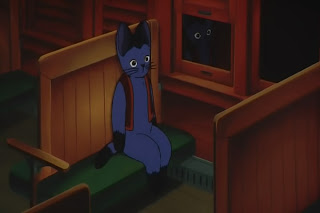 The symbolism of the film is certainly open to debate, and I think everyone should make up their own minds about it for the most part. Miyazawa apparently wrote it at least in part as a meditation on the death of his beloved sister, and themes of death are quite plain throughout the film. Campanella climbs aboard the train through a window, his coat wet for some reason. An odd cast of characters are encountered along the way, and the train passes through the constellations, each with a story behind them. There are child victims of the Titanic (the only humans in the film), who disembark at the Southern Cross, a kind of Christian Heaven (indeed, Christian symbolism is prevalent in the film and novel). But that’s not the final station – the train continues to what Campanella calls “The True Heaven”, a hole in the sky called The Coal Sack. It’s there he disembarks, leaving a tearful Giovanni behind forever.
The symbolism of the film is certainly open to debate, and I think everyone should make up their own minds about it for the most part. Miyazawa apparently wrote it at least in part as a meditation on the death of his beloved sister, and themes of death are quite plain throughout the film. Campanella climbs aboard the train through a window, his coat wet for some reason. An odd cast of characters are encountered along the way, and the train passes through the constellations, each with a story behind them. There are child victims of the Titanic (the only humans in the film), who disembark at the Southern Cross, a kind of Christian Heaven (indeed, Christian symbolism is prevalent in the film and novel). But that’s not the final station – the train continues to what Campanella calls “The True Heaven”, a hole in the sky called The Coal Sack. It’s there he disembarks, leaving a tearful Giovanni behind forever.
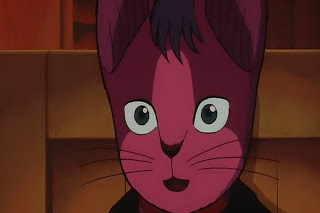 What’s happened to Campanella seems clear enough when Giovanni awakes on the hillside. Significantly, Giovanni’s ticket was different from all the others on the train – perhaps the only round-trip ticket. Campanella talks about the importance of doing good for its own sake, and speaks of hoping his mother will forgive him for what he’s done. One of the fellow passengers on the train, a man who captured herons to turn them into candy, had disappeared suddenly. This leads Giovanni to wish that they’d spoken more with the man, noting that he’d seemed like kind of an interruption but now he “feels kinda bad” that they hadn’t spoken more. The implication is clear here, but it isn’t always so clear. As mentioned Christian themes and images are common, but there are also strongly Buddhist themes of reincarnation and attachment to the material – in fact I think a case can be made the Miyazawa ultimately rejects Christian ideals in contrasting Campanella’s choices with those of the young man looking after the Titanic children. And then there’s the subject of fate, a common motif. And that’s where Mawaru comes in.
What’s happened to Campanella seems clear enough when Giovanni awakes on the hillside. Significantly, Giovanni’s ticket was different from all the others on the train – perhaps the only round-trip ticket. Campanella talks about the importance of doing good for its own sake, and speaks of hoping his mother will forgive him for what he’s done. One of the fellow passengers on the train, a man who captured herons to turn them into candy, had disappeared suddenly. This leads Giovanni to wish that they’d spoken more with the man, noting that he’d seemed like kind of an interruption but now he “feels kinda bad” that they hadn’t spoken more. The implication is clear here, but it isn’t always so clear. As mentioned Christian themes and images are common, but there are also strongly Buddhist themes of reincarnation and attachment to the material – in fact I think a case can be made the Miyazawa ultimately rejects Christian ideals in contrasting Campanella’s choices with those of the young man looking after the Titanic children. And then there’s the subject of fate, a common motif. And that’s where Mawaru comes in.
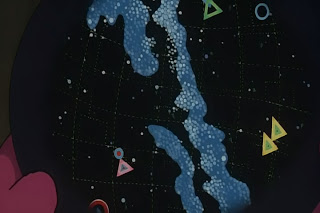 Ikuhara wasn’t terribly subtle about the links between his anime and Miyazawa’s story – he had two boys talking about the anime in the very first episode. I don’t think too much should be made of this – MPD is not a retelling of “Railroad”. But there are shared themes. The apple – “Ringo” – plays a major role in “Railroad”, with the doomed children of the Titanic holding perfect red apples as they approach heaven. And there’s the matter of trains, and railing (pun intended) against fate – something Shouma and Kanba do quite early on in the series as well. A train, after all, can only go where it’s track allows it to go – and it’s quite clear where the train in Miyazawa’s story is going. Predeterminism is a key component of both stories – the notion of trying to change a fate that’s already been decided, a “survival strategy” if you will. It’s no coincidence that trains play such a huge role in MPD, right down to the eyecatches (and you’ll notice, the train in the eyecatch graphic only goes in one direction). If you’re a fan of happy endings, the strong parallels between these two stories can’t fill you with an overwhelming sense of hope.
Ikuhara wasn’t terribly subtle about the links between his anime and Miyazawa’s story – he had two boys talking about the anime in the very first episode. I don’t think too much should be made of this – MPD is not a retelling of “Railroad”. But there are shared themes. The apple – “Ringo” – plays a major role in “Railroad”, with the doomed children of the Titanic holding perfect red apples as they approach heaven. And there’s the matter of trains, and railing (pun intended) against fate – something Shouma and Kanba do quite early on in the series as well. A train, after all, can only go where it’s track allows it to go – and it’s quite clear where the train in Miyazawa’s story is going. Predeterminism is a key component of both stories – the notion of trying to change a fate that’s already been decided, a “survival strategy” if you will. It’s no coincidence that trains play such a huge role in MPD, right down to the eyecatches (and you’ll notice, the train in the eyecatch graphic only goes in one direction). If you’re a fan of happy endings, the strong parallels between these two stories can’t fill you with an overwhelming sense of hope.
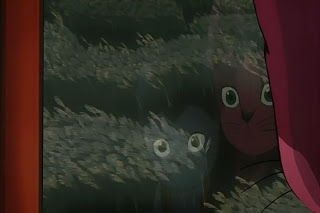 But, as I said, that’s probably being too literal – “Night on the Galactic Railroad” is only one of many cultural influences visible in MPD. We know there are themes connected to the Kobe earthquake and the Sarin gas attacks as well (that’s hardly optimistic either, is it?), and those might be explored more closely in the story Himari was searching for in the sort of “Galactic Library” in episode 9, Murakami’s “Super Frog Saves Tokyo”. And I really think modern anime fans should watch this film whether they’re fans of MPD or not – it’s one of the better theatrical anime of the 1980’s and a style not terribly popular anymore. If you’re like me you’ll find yourself caught up in the thoughtful and slightly surreal world Sugii creates out of Miyazawa’s story, and be quite moved by the ending. I strongly recommend you check it out, and make sure to watch through the credits – not just for the voice-over narration, but the thought-provoking and mysterious final title card.
But, as I said, that’s probably being too literal – “Night on the Galactic Railroad” is only one of many cultural influences visible in MPD. We know there are themes connected to the Kobe earthquake and the Sarin gas attacks as well (that’s hardly optimistic either, is it?), and those might be explored more closely in the story Himari was searching for in the sort of “Galactic Library” in episode 9, Murakami’s “Super Frog Saves Tokyo”. And I really think modern anime fans should watch this film whether they’re fans of MPD or not – it’s one of the better theatrical anime of the 1980’s and a style not terribly popular anymore. If you’re like me you’ll find yourself caught up in the thoughtful and slightly surreal world Sugii creates out of Miyazawa’s story, and be quite moved by the ending. I strongly recommend you check it out, and make sure to watch through the credits – not just for the voice-over narration, but the thought-provoking and mysterious final title card.
![cor.movie.night.on.the.galactic.railroad.v2.[D6AA0AD1].mkv_snapshot_00.38.54_[2011.09.21_18.54.56] cor.movie.night.on.the.galactic.railroad.v2.[D6AA0AD1].mkv_snapshot_00.38.54_[2011.09.21_18.54.56]](https://lh6.ggpht.com/-OEIUFclOxPs/Tnq05kZp9MI/AAAAAAAATLo/h8teWt8-ZxU/cor.movie.night.on.the.galactic.railroad.v2.%25255BD6AA0AD1%25255D.mkv_snapshot_00.38.54_%25255B2011.09.21_18.54.56%25255D_thumb%25255B1%25255D.jpg?imgmax=800) |
![cor.movie.night.on.the.galactic.railroad.v2.[D6AA0AD1].mkv_snapshot_00.42.51_[2011.09.21_18.58.53] cor.movie.night.on.the.galactic.railroad.v2.[D6AA0AD1].mkv_snapshot_00.42.51_[2011.09.21_18.58.53]](https://lh4.ggpht.com/--YODfS67hjQ/Tnq07dZImCI/AAAAAAAATLw/fBkT_bapPyM/cor.movie.night.on.the.galactic.railroad.v2.%25255BD6AA0AD1%25255D.mkv_snapshot_00.42.51_%25255B2011.09.21_18.58.53%25255D_thumb%25255B1%25255D.jpg?imgmax=800) |
![cor.movie.night.on.the.galactic.railroad.v2.[D6AA0AD1].mkv_snapshot_00.45.28_[2011.09.21_19.01.30] cor.movie.night.on.the.galactic.railroad.v2.[D6AA0AD1].mkv_snapshot_00.45.28_[2011.09.21_19.01.30]](https://lh6.ggpht.com/-dM4-iImKnbk/Tnq08wxwQWI/AAAAAAAATL4/dA6ZXPKezy8/cor.movie.night.on.the.galactic.railroad.v2.%25255BD6AA0AD1%25255D.mkv_snapshot_00.45.28_%25255B2011.09.21_19.01.30%25255D_thumb%25255B1%25255D.jpg?imgmax=800) |
![cor.movie.night.on.the.galactic.railroad.v2.[D6AA0AD1].mkv_snapshot_00.54.40_[2011.09.21_19.10.42] cor.movie.night.on.the.galactic.railroad.v2.[D6AA0AD1].mkv_snapshot_00.54.40_[2011.09.21_19.10.42]](https://lh5.ggpht.com/-uggOhRfXzLs/Tnq0-jl8C2I/AAAAAAAATMA/9Rg1SkkEc0U/cor.movie.night.on.the.galactic.railroad.v2.%25255BD6AA0AD1%25255D.mkv_snapshot_00.54.40_%25255B2011.09.21_19.10.42%25255D_thumb%25255B1%25255D.jpg?imgmax=800) |
![cor.movie.night.on.the.galactic.railroad.v2.[D6AA0AD1].mkv_snapshot_01.04.26_[2011.09.21_19.20.30] cor.movie.night.on.the.galactic.railroad.v2.[D6AA0AD1].mkv_snapshot_01.04.26_[2011.09.21_19.20.30]](https://lh6.ggpht.com/-FrPm19WKGtE/Tnq1AvoJ7wI/AAAAAAAATMI/37aKV3O5VEs/cor.movie.night.on.the.galactic.railroad.v2.%25255BD6AA0AD1%25255D.mkv_snapshot_01.04.26_%25255B2011.09.21_19.20.30%25255D_thumb%25255B2%25255D.jpg?imgmax=800) |
![cor.movie.night.on.the.galactic.railroad.v2.[D6AA0AD1].mkv_snapshot_01.05.30_[2011.09.21_19.21.38] cor.movie.night.on.the.galactic.railroad.v2.[D6AA0AD1].mkv_snapshot_01.05.30_[2011.09.21_19.21.38]](https://lh6.ggpht.com/-H2SmJnG1Bdw/Tnq1B4Ik2dI/AAAAAAAATMQ/ZOdt9FHWV7A/cor.movie.night.on.the.galactic.railroad.v2.%25255BD6AA0AD1%25255D.mkv_snapshot_01.05.30_%25255B2011.09.21_19.21.38%25255D_thumb%25255B1%25255D.jpg?imgmax=800) |
![cor.movie.night.on.the.galactic.railroad.v2.[D6AA0AD1].mkv_snapshot_01.08.59_[2011.09.21_19.25.07] cor.movie.night.on.the.galactic.railroad.v2.[D6AA0AD1].mkv_snapshot_01.08.59_[2011.09.21_19.25.07]](https://lh4.ggpht.com/-1VHP5aoNoME/Tnq1Ds_vaUI/AAAAAAAATMY/O4z9SnmqOdY/cor.movie.night.on.the.galactic.railroad.v2.%25255BD6AA0AD1%25255D.mkv_snapshot_01.08.59_%25255B2011.09.21_19.25.07%25255D_thumb%25255B1%25255D.jpg?imgmax=800) |
![cor.movie.night.on.the.galactic.railroad.v2.[D6AA0AD1].mkv_snapshot_01.10.37_[2011.09.21_19.26.45] cor.movie.night.on.the.galactic.railroad.v2.[D6AA0AD1].mkv_snapshot_01.10.37_[2011.09.21_19.26.45]](https://lh5.ggpht.com/-NOvorY4LpE4/Tnq1Fu68tTI/AAAAAAAATMg/83nQZ1gu6y4/cor.movie.night.on.the.galactic.railroad.v2.%25255BD6AA0AD1%25255D.mkv_snapshot_01.10.37_%25255B2011.09.21_19.26.45%25255D_thumb%25255B1%25255D.jpg?imgmax=800) |
![cor.movie.night.on.the.galactic.railroad.v2.[D6AA0AD1].mkv_snapshot_01.12.53_[2011.09.21_19.29.49] cor.movie.night.on.the.galactic.railroad.v2.[D6AA0AD1].mkv_snapshot_01.12.53_[2011.09.21_19.29.49]](https://lh5.ggpht.com/-BnHOYVnc_14/Tnq1HYSBCkI/AAAAAAAATMo/3mzYuELTckA/cor.movie.night.on.the.galactic.railroad.v2.%25255BD6AA0AD1%25255D.mkv_snapshot_01.12.53_%25255B2011.09.21_19.29.49%25255D_thumb%25255B1%25255D.jpg?imgmax=800) |
![cor.movie.night.on.the.galactic.railroad.v2.[D6AA0AD1].mkv_snapshot_01.20.43_[2011.09.21_19.38.41] cor.movie.night.on.the.galactic.railroad.v2.[D6AA0AD1].mkv_snapshot_01.20.43_[2011.09.21_19.38.41]](https://lh3.ggpht.com/-5AS_vfU4yEU/Tnq1Jfz7qTI/AAAAAAAATMw/vhQb-FVV8xg/cor.movie.night.on.the.galactic.railroad.v2.%25255BD6AA0AD1%25255D.mkv_snapshot_01.20.43_%25255B2011.09.21_19.38.41%25255D_thumb%25255B1%25255D.jpg?imgmax=800) |
![cor.movie.night.on.the.galactic.railroad.v2.[D6AA0AD1].mkv_snapshot_01.27.11_[2011.09.21_19.45.09] cor.movie.night.on.the.galactic.railroad.v2.[D6AA0AD1].mkv_snapshot_01.27.11_[2011.09.21_19.45.09]](https://lh4.ggpht.com/-SEDj_RrRRDs/Tnq1LFqx7DI/AAAAAAAATM4/VbpOws28A30/cor.movie.night.on.the.galactic.railroad.v2.%25255BD6AA0AD1%25255D.mkv_snapshot_01.27.11_%25255B2011.09.21_19.45.09%25255D_thumb%25255B1%25255D.jpg?imgmax=800) |
![cor.movie.night.on.the.galactic.railroad.v2.[D6AA0AD1].mkv_snapshot_01.28.38_[2011.09.21_19.46.36] cor.movie.night.on.the.galactic.railroad.v2.[D6AA0AD1].mkv_snapshot_01.28.38_[2011.09.21_19.46.36]](https://lh5.ggpht.com/-HAhOp_7layM/Tnq1NNGGdUI/AAAAAAAATNA/_Lw7crHMvco/cor.movie.night.on.the.galactic.railroad.v2.%25255BD6AA0AD1%25255D.mkv_snapshot_01.28.38_%25255B2011.09.21_19.46.36%25255D_thumb%25255B1%25255D.jpg?imgmax=800) |
![cor.movie.night.on.the.galactic.railroad.v2.[D6AA0AD1].mkv_snapshot_01.28.40_[2011.09.21_19.46.38] cor.movie.night.on.the.galactic.railroad.v2.[D6AA0AD1].mkv_snapshot_01.28.40_[2011.09.21_19.46.38]](https://lh3.ggpht.com/-5hLy9FFat6Y/Tnq1OqPuj7I/AAAAAAAATNI/pVffzz_UCqc/cor.movie.night.on.the.galactic.railroad.v2.%25255BD6AA0AD1%25255D.mkv_snapshot_01.28.40_%25255B2011.09.21_19.46.38%25255D_thumb%25255B2%25255D.jpg?imgmax=800) |
![cor.movie.night.on.the.galactic.railroad.v2.[D6AA0AD1].mkv_snapshot_01.30.07_[2011.09.21_19.48.05] cor.movie.night.on.the.galactic.railroad.v2.[D6AA0AD1].mkv_snapshot_01.30.07_[2011.09.21_19.48.05]](https://lh5.ggpht.com/-SxxpuWH20y4/Tnq1Qqp4OpI/AAAAAAAATNQ/LDhZAGIcSYs/cor.movie.night.on.the.galactic.railroad.v2.%25255BD6AA0AD1%25255D.mkv_snapshot_01.30.07_%25255B2011.09.21_19.48.05%25255D_thumb%25255B1%25255D.jpg?imgmax=800) |
![cor.movie.night.on.the.galactic.railroad.v2.[D6AA0AD1].mkv_snapshot_01.30.50_[2011.09.21_19.48.48] cor.movie.night.on.the.galactic.railroad.v2.[D6AA0AD1].mkv_snapshot_01.30.50_[2011.09.21_19.48.48]](https://lh6.ggpht.com/-GYz4A3VwDuQ/Tnq1SPnLaJI/AAAAAAAATNY/y8EcnJj1Fys/cor.movie.night.on.the.galactic.railroad.v2.%25255BD6AA0AD1%25255D.mkv_snapshot_01.30.50_%25255B2011.09.21_19.48.48%25255D_thumb%25255B1%25255D.jpg?imgmax=800) |
![cor.movie.night.on.the.galactic.railroad.v2.[D6AA0AD1].mkv_snapshot_01.32.27_[2011.09.21_19.50.25] cor.movie.night.on.the.galactic.railroad.v2.[D6AA0AD1].mkv_snapshot_01.32.27_[2011.09.21_19.50.25]](https://lh6.ggpht.com/-xrobuYGmyJ4/Tnq1UGuTftI/AAAAAAAATNg/Jfk6pAGvgPI/cor.movie.night.on.the.galactic.railroad.v2.%25255BD6AA0AD1%25255D.mkv_snapshot_01.32.27_%25255B2011.09.21_19.50.25%25255D_thumb%25255B1%25255D.jpg?imgmax=800) |
![cor.movie.night.on.the.galactic.railroad.v2.[D6AA0AD1].mkv_snapshot_01.34.43_[2011.09.21_19.52.41] cor.movie.night.on.the.galactic.railroad.v2.[D6AA0AD1].mkv_snapshot_01.34.43_[2011.09.21_19.52.41]](https://lh4.ggpht.com/-0N3jsrH8yDY/Tnq1Vo_rrCI/AAAAAAAATNo/vX8hAd-x6oE/cor.movie.night.on.the.galactic.railroad.v2.%25255BD6AA0AD1%25255D.mkv_snapshot_01.34.43_%25255B2011.09.21_19.52.41%25255D_thumb%25255B1%25255D.jpg?imgmax=800) |
![cor.movie.night.on.the.galactic.railroad.v2.[D6AA0AD1].mkv_snapshot_01.35.37_[2011.09.21_19.53.35] cor.movie.night.on.the.galactic.railroad.v2.[D6AA0AD1].mkv_snapshot_01.35.37_[2011.09.21_19.53.35]](https://lh4.ggpht.com/-TSI3ITJeQoI/Tnq1Wye2NmI/AAAAAAAATNw/xJ_hJtCUiSs/cor.movie.night.on.the.galactic.railroad.v2.%25255BD6AA0AD1%25255D.mkv_snapshot_01.35.37_%25255B2011.09.21_19.53.35%25255D_thumb%25255B1%25255D.jpg?imgmax=800) |
![cor.movie.night.on.the.galactic.railroad.v2.[D6AA0AD1].mkv_snapshot_01.36.53_[2011.09.21_19.54.51] cor.movie.night.on.the.galactic.railroad.v2.[D6AA0AD1].mkv_snapshot_01.36.53_[2011.09.21_19.54.51]](https://lh6.ggpht.com/-AB0oK1bYy34/Tnq1YAxjf4I/AAAAAAAATN4/0aSN-K9Q0Aw/cor.movie.night.on.the.galactic.railroad.v2.%25255BD6AA0AD1%25255D.mkv_snapshot_01.36.53_%25255B2011.09.21_19.54.51%25255D_thumb%25255B1%25255D.jpg?imgmax=800) |
![cor.movie.night.on.the.galactic.railroad.v2.[D6AA0AD1].mkv_snapshot_01.41.52_[2011.09.21_19.59.50] cor.movie.night.on.the.galactic.railroad.v2.[D6AA0AD1].mkv_snapshot_01.41.52_[2011.09.21_19.59.50]](https://lh5.ggpht.com/-CmOAPA-MXnE/Tnq1ZbNFnxI/AAAAAAAATOA/JAw0laNggzo/cor.movie.night.on.the.galactic.railroad.v2.%25255BD6AA0AD1%25255D.mkv_snapshot_01.41.52_%25255B2011.09.21_19.59.50%25255D_thumb%25255B2%25255D.jpg?imgmax=800) |
![cor.movie.night.on.the.galactic.railroad.v2.[D6AA0AD1].mkv_snapshot_01.43.17_[2011.09.21_20.01.15] cor.movie.night.on.the.galactic.railroad.v2.[D6AA0AD1].mkv_snapshot_01.43.17_[2011.09.21_20.01.15]](https://lh3.ggpht.com/-emniIHuKILc/Tnq1aqLKscI/AAAAAAAATOI/aBuURGztR-Y/cor.movie.night.on.the.galactic.railroad.v2.%25255BD6AA0AD1%25255D.mkv_snapshot_01.43.17_%25255B2011.09.21_20.01.15%25255D_thumb%25255B1%25255D.jpg?imgmax=800) |



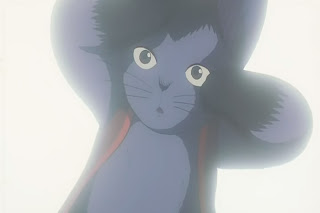
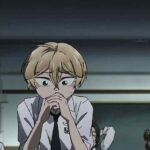
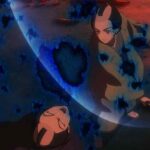
Anonymous
September 22, 2011 at 12:56 pmIs the book still sold in bookstores?
admin
September 22, 2011 at 4:35 pmNot as far as I know. I think the library is your best bet.
Anonymous
September 22, 2011 at 8:54 pmThanks. I definitely am going to watch the movie and I would love to read the book someday.
admin
September 23, 2011 at 12:43 amYou might also find it as part of a Miyazawa collection, as it's basically a short story.
Kim
September 23, 2011 at 1:28 amThere is actually really good interview explaining some of the choices made about the anime's interpretation of the story (including turning the characters into cats).
Translated here:
http://www.pelleas.net/aniTOP/index.php?c=1&more=1&p=182&pb=1&tb=1
admin
September 23, 2011 at 2:32 amThanks, Kim – very interesting stuff.